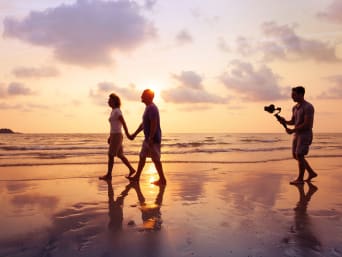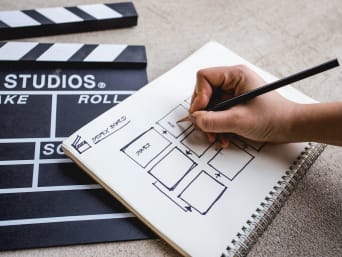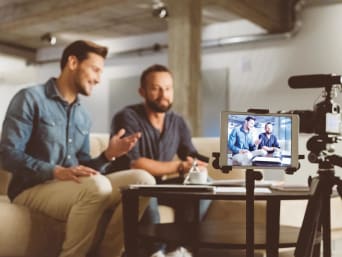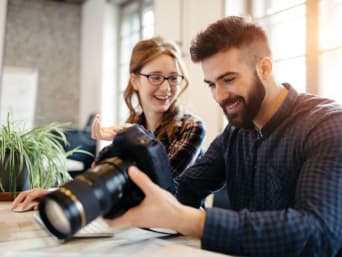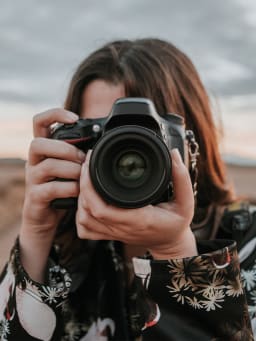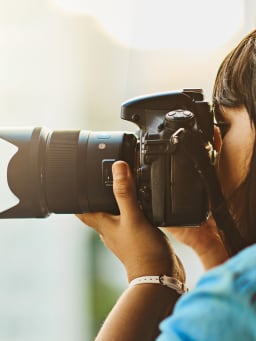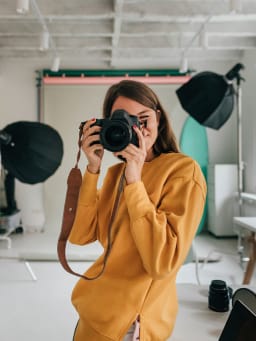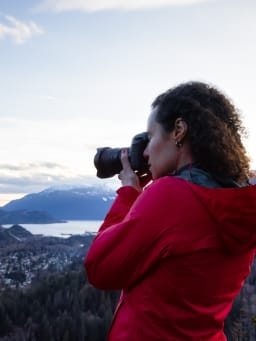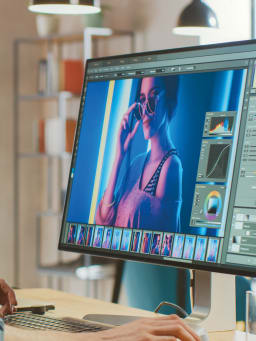Videography: making videos for beginners
Making your own film is a dream for many film fans. However, there is more to making films than just pressing "record". To ensure that your first video is a complete success, there are a few things you can consider during the planning and preparation that will make taking the video easier. In this article, we will show you what you need to consider when taking your first video, what camera accessories you will need and which camera settings are best suited to beginners.
Making videos: tips on camera accessories for beginners
You don't usually need a lot of camera accessories to make your first film as it’s more important to learn the ropes first. To shoot your own videos, you can either use your smartphone or get a camera. Investing in your first camera that is easy to use is worthwhile if you would like to pursue videography or if you also have an interest in photography.
Generally, you can make good films with an SLR or mirrorless camera. When getting your first camera make sure that it has good video quality such as full HD, i.e. 1920 x 1080 pixels, and it should also be able to maintain this at high frame rates (50 fps to 100 fps). You can find more recommendations and information on which cameras and lenses are ideal for beginners and filming in our article "Photography tips for beginners".
In addition to choosing the right camera, you can also buy some camera accessories to help you get started:
Microphone: an external microphone is often indispensable for good sound recordings. Simple clip-on microphones are recommended for recording dialogue and conversations. However, make sure you also buy the appropriate windscreen so that sound recordings also work well outdoors.
Memory cards: to record several scenes in different settings you will need a lot of space. Therefore, you should use memory cards with a high capacity such as 128 GB or 256 GB.
Spare battery: by having a spare battery you can record for longer without your camera running out of battery.
Light: if you are planning to film indoors you will also need good lighting source as well. LED daylight luminaires are recommended for this.
Grey filter: you can use a grey filter to prevent your video recordings from being overexposed to daylight. This way you can have a longer exposure time even when the sun is shining.
Masking tape: you can use masking tape to mark the position of the actors. This makes it easier for you to focus on them whilst filming.
Video editing programme: a free video editing software is sufficient to start off with. When you want to make further changes or develop your videos you can then switch and pay for a more professional software.
Tips on how to prepare for making your first film
Ideally, your film will tell a story that the viewers can enjoy and follow. Therefore, it is important to first get an idea of what the film should be about. Think about what story your film will tell, what messages you want to convey and have a think about how you would like to shoot it. These are the basic preparations needed to make your own first film.
Once you have an idea, you can make further preparations that will make it easier for you to shoot your first film:
Process or story board: start by writing down a rough plan and include which scenes you would like to have. In addition, make notes on which details and perspectives you would like to capture and in which order the scenes should appear in at the end.
Planning: you should plan each day in advance to ensure that everything is ready on the day of the shoot. It is a good idea to check your locations and lighting beforehand. In addition, make sure to write down which props, costumes or outfits you are going to need and inform any actors about the location and time of the shoot. If you are making a film with your friends, then you can also share and complete the tasks in advance.
Take notes: take notes during the shoot and tick off any completed tasks. It is a good idea to note down any particularly successful shots or write down some editing notes. This will make it easier when it comes to editing your video later.
Time: leave enough time for making videos. This is especially important when recording a scene several times and using different perspectives that you can then merge when editing the video. To make editing easier, you can also record a few extra seconds at the beginning and end of each shot.
Consistency: whilst filming make sure that there are no inconsistencies between the different scenes such as different clothes or furniture.
Background: what does the background in your shot look like? Do you want a busy background or a quiet background? Are there elements that interfere with the background?
Light: the best times of day for making a video are in the morning and in the afternoon. At those times of day, the light is usually softer than at midday. Therefore, it is a good idea to organise your shoots during the suggested times for outdoor shots.
Sound: it is recommended to make a test recording at the locations of where you will be filming to check the sound. Background noises such as street noise or aeroplanes can be distracting later in the film. It is best to work with a microphone if the background noise is unavoidable. When editing your videos, you can improve the quality of the sound. Whilst filming, you should also regularly check that the recording level is correct and that the microphone has not fallen out of place.

Make sure to get written consent from any actors beforehand if you are planning on having actors in your film. You will be required to get permission when filming at certain locations such as private property. You should also make sure that you own the rights to any music you intend to use in your film. It is best to organise all of this before making your film.
Videography: the ideal camera settings for making videos
It isn’t always easy to find the correct settings for making a video with your first camera. Try the following camera settings to ensure that your film is well exposed and sharp:
Frame rate: is the easiest way to shoot your film at the rate you would like it to be shot at. Whilst filming, your camera will record a lot of individual images that are played back quickly to create a moving picture. Conversations and slow scenes are usually recorded at 24 fps (frames per second). Action scenes can be shot at 50 to 60 fps to slow down the image and make fast-moving action seem more realistic. Slow-motion scenes on the other hand, are filmed at 100 to 120 fps.
Resolution: when getting stared it is usually enough to shoot your scenes in Full HD or 1080p. The "p" stands for "progressive" and this means that the images are recorded simultaneously, which means that there will be no flicker.
Shutter speed: most videos are shot with a shutter speed of 1/50 sec. This creates a slight blur in the movement, which adapts the image to our viewing habits and makes it look so natural.
Aperture: you can set the aperture yourself depending on the desired effect of the image. An open aperture blurs the background, whilst a closed aperture also sharpens the background. Your videos may be overexposed even at a 100 ISO setting whilst filming outside with an open aperture. In this case it is recommended to use a grey filter.
Focus: whilst filming you can work most precisely with a manually set focus. However, this requires a little practice. It is easier if objects and actors are therefore in predefined positions. In addition, a closed aperture (approx. f4 to f5.6) gives you more leeway when focusing.
The above camera settings are only a couple of recommendations. You can also try out different settings on your camera to find the perfect match.

Before starting to film with your camera, you should first familiarise yourself with your camera and learn how aperture, ISO and shutter speed work. It is also an advantage if you learn the basic rules of image composition before making your first videos. You can find more information and an introduction to these topics in the following article: "Camera settings and learning how to take photos’’.
Making your own films: a helpful checklist for your videos
The checklist below is for filming and it has a couple of helpful tips and reminders for videography beginners:
Have you decided on the order of the different scenes?
Have the actors been informed about the film?
Are all the props ready?
Are there any distracting elements in the background?
Have you got the correct lighting? Is the video bright enough?
Is the focus set correctly?
Is the recording rate correct?
How is the sound quality of the recording?
Did you record the different scenes several times?
Have you made sure that there is consistency between the different scenes?
Making your own film: video editing
Once you have finished filming all the scenes the next step is to edit your video. For beginners it is recommended to use a free video editing software until you have become familiar with the process. These types of video editing software usually have more options than beginners will usually need. Follow the tips below if you are creating your own film:
Cuts & transition fades: whilst editing on such software you will usually find a variety of transition fades. As a rule, you can use a hard cut and a fade at the beginning. You then use the aperture for time and location jumps, while you can change the perspective with the cut.
Editing: each time you edit your video it will have a different type of effect. Harmonious landscape shots are usually edited slowly, whereas action scenes require faster cuts to create dynamics. You can also change the speed of the video whilst editing it and then adapt it to the scene.
Colour grading: you can adjust the colours and exposure of videos. You can find further tips on colour editing videos and photos in the following article "Photo Editing".
Music & sound effects: the correct music and sound effects can help to highlight the message in a particular scene. Always make sure to choose the appropriate music to help prepare the audience for the upcoming scene, which will help to draw their attention to the upcoming scene.
Sound quality: whilst editing your video you can improve the sound quality or replace a specific soundtrack with a new one. By doing so you can correct any errors in the sound recording.

Besides a few extra seconds before and after each scene, cutaways can also make your video editing easier. These are usually close-ups of objects, people or movements (e.g. walking) that slowly lead into a particular scene.
Conclusion: videography for beginners – tips on how to make a film
The most important things for making your own first film are having a good idea what type of film you would like to make as well as being well organised with your planning. These two key things make filming and editing a film a lot easier. Whilst filming make sure that everything has been organised and that the camera settings and sound are correct so that the scene can be filmed how you have envisaged it. Afterwards whilst editing your film you will only have to put everything together and transform it into a masterpiece by adding the finishing touches such as music. By following the tips above they will help you each step of the way when making your first film.
______________________________________________
References
https://www.learnaboutfilm.com/making-a-film/
(last accessed on 01.11.2022)
https://visme.co/blog/video-tips/
(last accessed on 01.11.2022)
https://vloguide.com/videography-tips/
(last accessed on 01.11.2022)
Image sources
iStock.com/undefined undefined
iStock.com/anyaberkut
iStock.com/pomphotomine
iStock.com/izusek
iStock.com/nd3000

